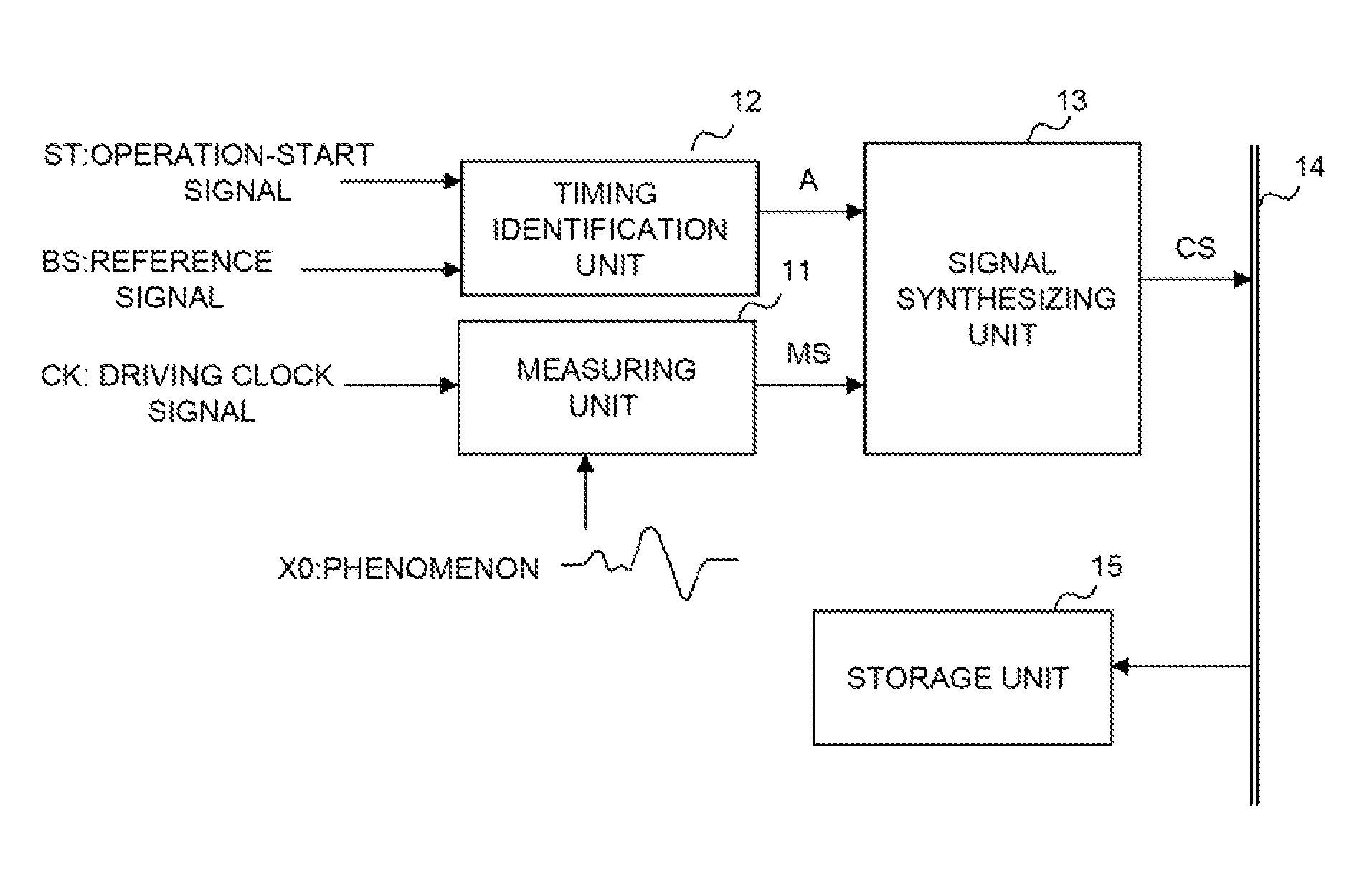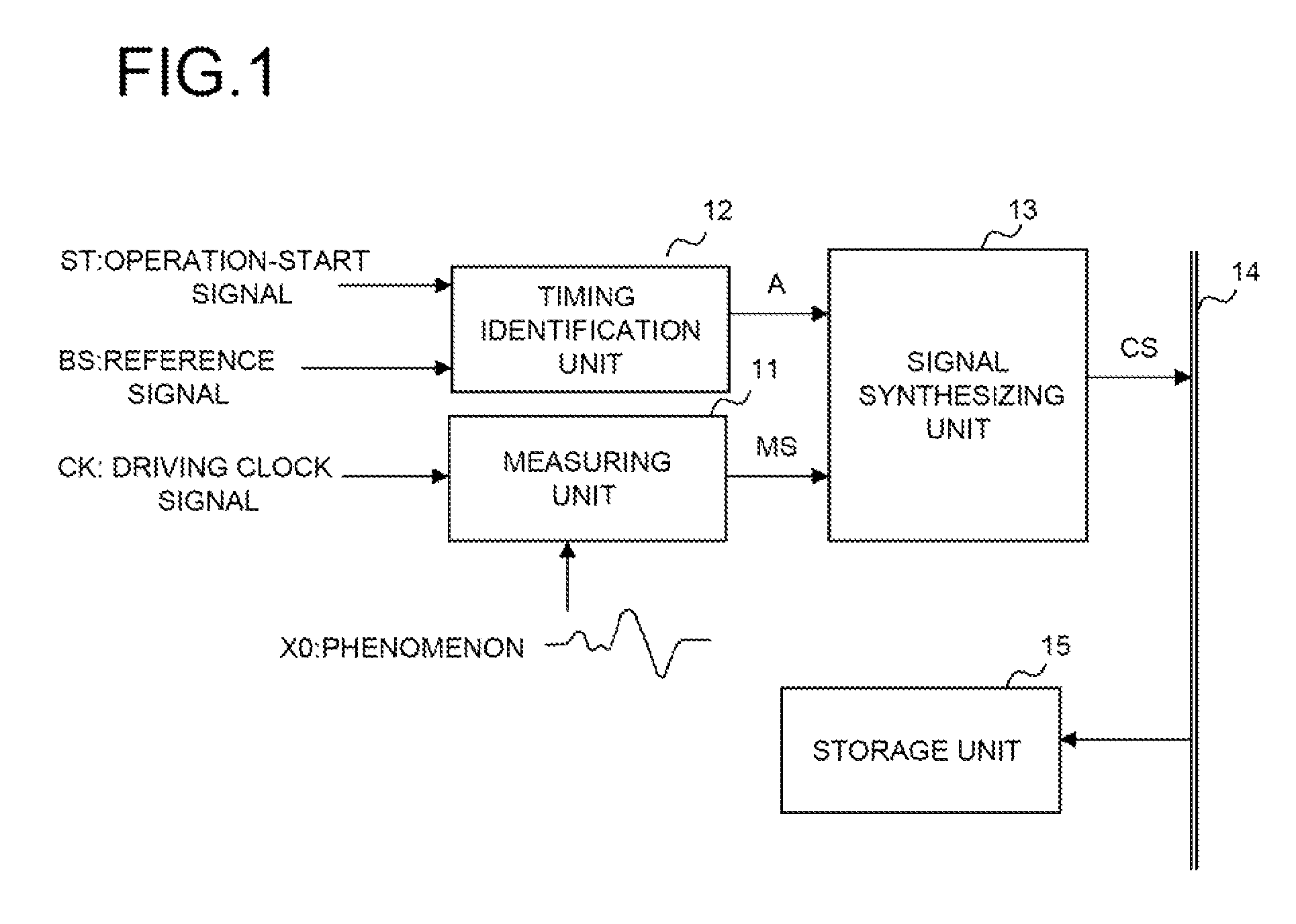Signal measuring device and signal measuring method
a signal measuring and signal technology, applied in the direction of instruments, pulse manipulation, pulse technique, etc., can solve the problems of difficult to readily estimate malfunction, noise, clock fluctuation (jitter) and temperature variations, and increase in the case of chip malfunction, so as to achieve satisfactory precision and estimate the measurement time
- Summary
- Abstract
- Description
- Claims
- Application Information
AI Technical Summary
Benefits of technology
Problems solved by technology
Method used
Image
Examples
first exemplary embodiment
(Method of storing all measurement data in memory in order)
[0078]FIG. 1 is a block diagram illustrating the configuration of a signal measuring device according to a first exemplary embodiment of the present invention. The signal measuring device in FIG. 1 includes a measuring unit 11, a timing identification unit 12, a signal synthesizing unit 13, a data bus 14 and a storage unit 15. The measuring unit 11 measures a phenomenon X0 in synch with a driving clock signal CK that is for measuring purposes and outputs a measurement result every period of the driving clock signal CK as a measurement-result signal MS. Meanwhile, the timing identification unit 12, which identifies the timing at which the measuring unit 11 operates, receives as inputs an operation-start signal ST, which is used as timing for starting the output of measurement data, and a reference signal BS that rises at a fixed period, and outputs an identification signal A. The signal synthesizing unit 13 generates a synthe...
second exemplary embodiment
Method of Storing Random Data of Measurement Data
[0089]The configuration of the signal measuring device according to the second exemplary embodiment of the present invention is similar to that shown in FIG. 1. However, the internal configuration of the timing identification unit 12 is different. The signal measuring device according to the second exemplary embodiment is illustrated with regard to a case where the measurement-result signals MS of all periods are stored in the storage unit 15 in FIG. 1 but no limitation is applied with respect to the order in which the data is written to the storage unit 15, i.e., the data is stored at addresses in the storage unit 15 in an order different from the order of generation, as illustrated in FIG. 10. When the stored synthesized signals are read out in this case, the data generation timing cannot be identified in order from the leading bit by the method shown in FIG. 5 if the order in which the measurement-result signals MS were generated c...
third exemplary embodiment
Method of Storing Some Measurement Data in Memory
[0096]FIG. 16 is a block diagram illustrating the configuration of a signal measuring device according to a third exemplary embodiment of the present invention. Components in FIG. 16 identical with those shown in FIG. 1 are designated by like reference characters and are not described again. A comparator 16 senses whether the measurement-result signal MS is outside the range of a reference value RE set in advance. If the measurement-result signal MS is outside the range of the reference value RE, i.e., if it is recognized that phenomenon X0 is abnormal, this fact is reported to an output controller 17. The output controller 17 transfers the synthesized signal CS, which is output by the signal synthesizing unit 13, to the storage unit 15 only in a case where phenomenon X0 is abnormal. If this arrangement is adopted, the overall number of items of data stored in the storage unit 15 can be reduced and a reduction in the amount of memory ...
PUM
 Login to View More
Login to View More Abstract
Description
Claims
Application Information
 Login to View More
Login to View More - R&D
- Intellectual Property
- Life Sciences
- Materials
- Tech Scout
- Unparalleled Data Quality
- Higher Quality Content
- 60% Fewer Hallucinations
Browse by: Latest US Patents, China's latest patents, Technical Efficacy Thesaurus, Application Domain, Technology Topic, Popular Technical Reports.
© 2025 PatSnap. All rights reserved.Legal|Privacy policy|Modern Slavery Act Transparency Statement|Sitemap|About US| Contact US: help@patsnap.com



